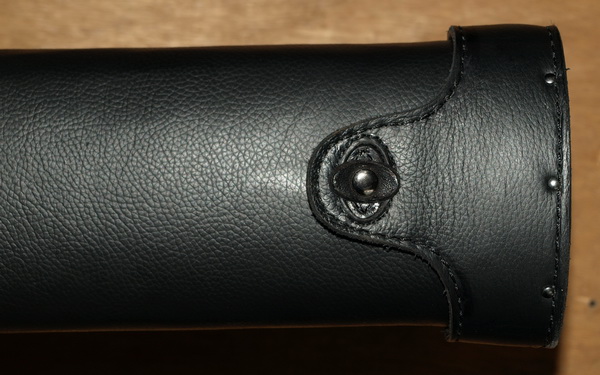I had no idea you would entertain such flexibility, I now have a question, could you do the twist latch front open, but do the latch itself out of steel or brass? Or maybe just explain the latch...is it just a piece of leather, or metal inside of leather?
The latch is made of veg tan leather that we have treated to be very firm. Those leather pieces are glued together and hand sewn to each other and then to the body of the case. It's reinforced with metal on the backside of the skin. The twist portion is a single piece of leather that has been hardened and it's attached with a securely set rivet.
The reason I don't use metal twist latches is that they break. When I owned Instroke I fought with those latches for ten years. Finally after ten years we (instroke) went ahead and created a metal latch that is strong enough for a cue case and still looks good. This is the Diamond Latch that Instroke uses.
So when I started JB Case my first thought was to create something similar and I did but the manufacturer did it wrong and it was weak. After some back and forth I finally got frustrated and decided that I was not going to depend on anyone else for my latches if I could avoid it. So I invented the puzzle latch as you see it here.
I do the magnetic version which has zero moving parts and the twist version which only has the one moving part. (as opposed to the type of twist latch out of metal that is typically seen on cases these days which have two or more parts inside that are moving.)
What I like about these in addition to the strength of them is the flexibility. I can customize them to fit any design as seen here:
Bruce was in law enforcement so I did one in a generic badge shape:
This is a reverse version where the brackets take all the weight so that the metal snap is not stressed. But I prefer not to use snaps at all when I don't have to.
I can use the space to personalize the case:
And I just think it looks better than a big hunk of metal. I can make it compliment the overall color theme or contrast it at will:
And if you're worried at all about how secure it is just ask those that own our cases. In the past three years I have only had one break and that was because the rivet was improperly installed. But even on that case the lid would still close securely because we fit each and every hand-built latch with little to no play so that the pressure alone is enough to keep the case closed.
Here are a couple videos of me demonstrating the latches.
Puzzle Twist:
http://www.youtube.com/watch?v=aWpKA_vys2Y
Magnetic Puzzle Latch:
http://www.youtube.com/watch?v=08-tBou425s
Magnetic Latch (Portugal Case):
http://www.youtube.com/watch?v=UeCRrsGlo9w
Magnetic Latch (JG Cues' Case 5x10):
http://www.youtube.com/watch?v=Ehr--5Ql7a0
As you will see I nearly break my wrist trying to get these cases to open by themselves.
Lastly, you can see some cases on my site that we did use metal twist latches. If you really want that type of latch I will do it and I will make sure that it is as secure as I can make it. But I give no warranty on latches I don't make so if it breaks all repair costs are on you. I have already been down that road with parts I don't make and don't wish to go there again. My friend Roy sells Murnak cases and he had three of these twist latches that Murnak uses break off in the customer's hands in his showroom the first time the customer tried to open the case. Not Murnak's fault really since he was only buying the commonly available latches of that type. These latches are made for purses and are not made to bear the weight of a cue case. So I would strongly discourage you from requesting a metal twist latch.
(unless you buy an Instroke and then be sure to get the Diamond latch, it's specifically made for cue cases and is proprietary to Instroke.) If I someday decide to mass produce cases with a twist latch then I am certain I will find a supplier I can work with and duplicate the Instroke latch.
So there you go, ask me what time it is and I will tell you how a watch is built











